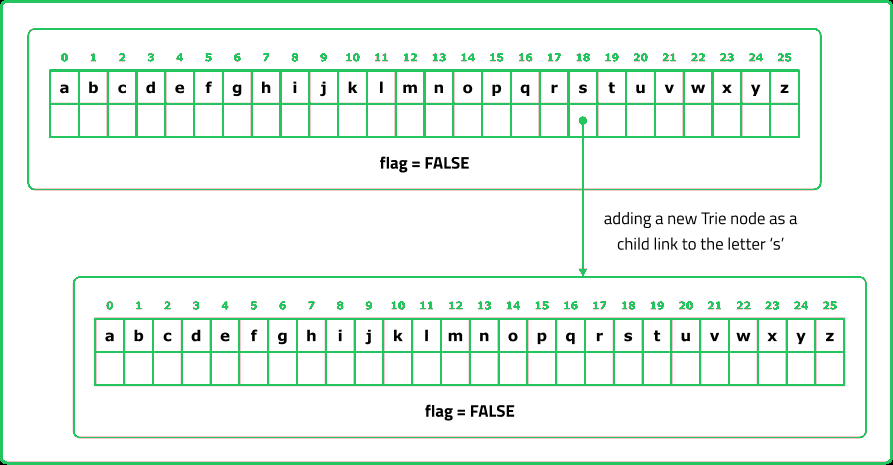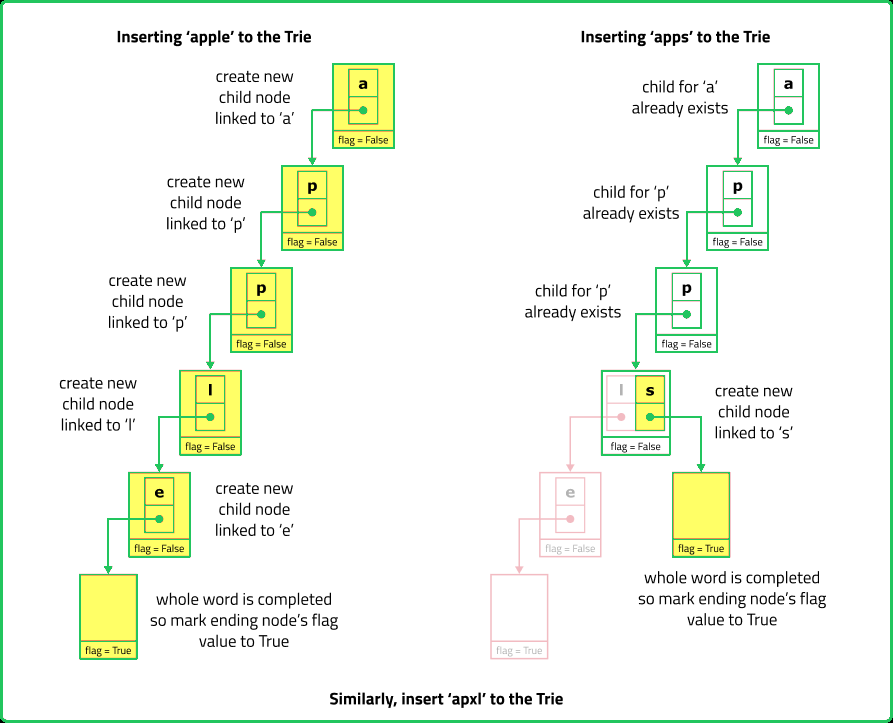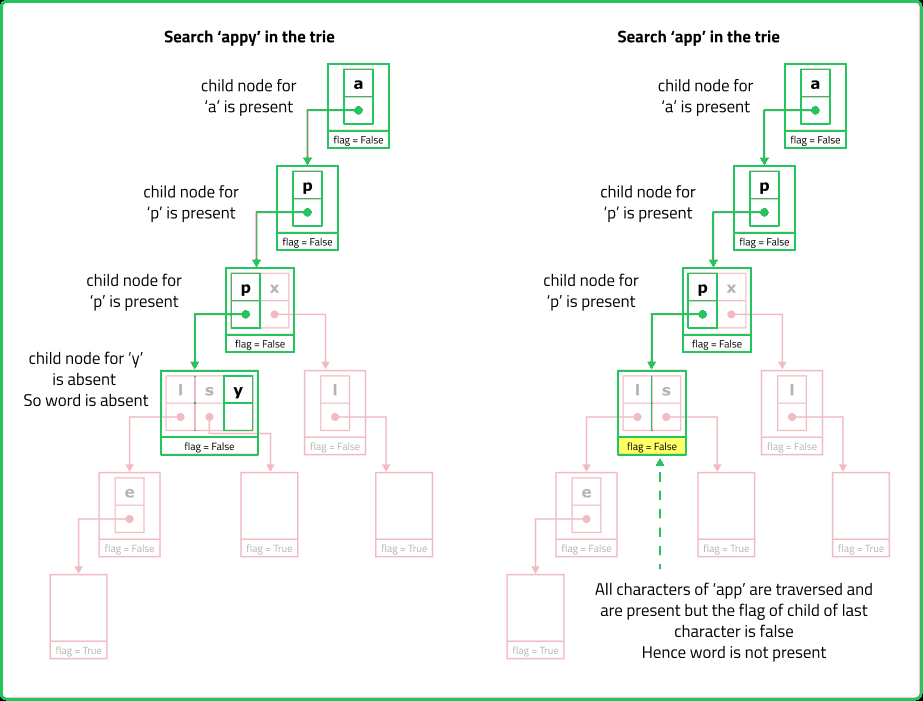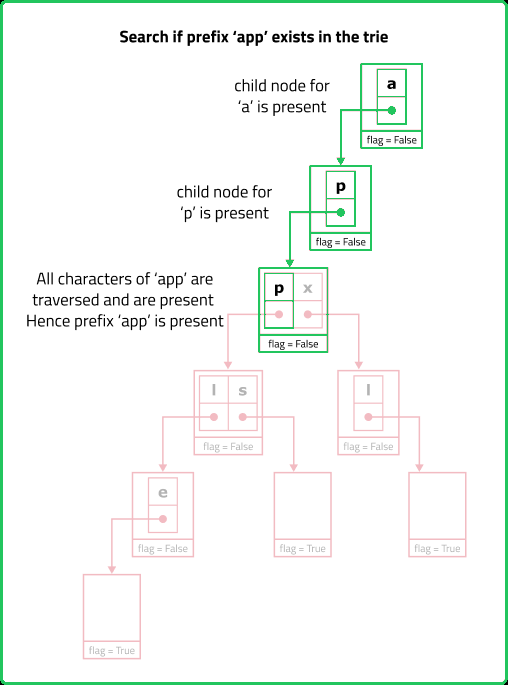123456789101112131415161718192021222324252627282930313233343536373839404142434445464748495051525354555657585960616263646566676869707172737475767778798081828384858687888990919293949596979899100101102103104105106107108109110111112113114115116117118119120121122123124125126127128129130131132133134135136137138139140141142143144145146147148149150151152
#include <bits/stdc++.h>
using namespace std;
// Node Structure for Trie
struct Node {
/*Array to store links to child nodes,
each index represents a letter*/
Node* links[26];
/* Flag indicating if
the node marks the end
of a word*/
bool flag = false;
/*Check if the node contains
a specific key (letter)*/
bool containsKey(char ch) {
return links[ch - 'a'] != NULL;
}
/* Insert a new node with a specific
key (letter) into the Trie*/
void put(char ch, Node* node) {
links[ch - 'a'] = node;
}
/*Get the node with a specific
key (letter) from the Trie*/
Node* get(char ch) {
return links[ch - 'a'];
}
/*Set the current node
as the end of a word*/
void setEnd() {
flag = true;
}
/*Check if the
current node marks
the end of a word*/
bool isEnd() {
return flag;
}
};
// Trie class
class Trie {
private:
Node* root;
public:
/* Constructor to
initialize the
Trie with an
empty root node*/
Trie() {
root = new Node();
}
/* Inserts a word into the Trie
Time Complexity O(len), where len
is the length of the word*/
void insert(string word) {
Node* node = root;
for (int i = 0; i < word.length(); i++) {
if (!node->containsKey(word[i])) {
/* Create a new node for
the letter if not present*/
node->put(word[i], new Node());
}
// Move to the next node
node = node->get(word[i]);
}
// Mark the end of the word
node->setEnd();
}
/*Returns if the word
is in the trie*/
bool search(string word) {
Node* node = root;
for (int i = 0; i < word.length(); i++) {
if (!node->containsKey(word[i])) {
/*If a letter is
not found,the word
is not in the Trie*/
return false;
}
// Move to the next node
node = node->get(word[i]);
}
/*Check if the last node
marks the end of a word*/
return node->isEnd();
}
/* Returns if there is any word in the
trie that starts with the given prefix*/
bool startsWith(string prefix) {
Node* node = root;
for (int i = 0; i < prefix.length(); i++) {
if (!node->containsKey(prefix[i])) {
/*If a letter is not
found, there is
no word with the
given prefix*/
return false;
}
// Move to the next node
node = node->get(prefix[i]);
}
// Prefix Found
return true;
}
};
int main() {
// Create a Trie object
Trie* trie = new Trie();
// Define input operations and arguments
vector<string> operations = {"Trie", "insert", "search", "search", "startsWith", "insert", "search"};
vector<vector<string>> arguments = { {}, {"apple"}, {"apple"}, {"app"}, {"app"}, {"app"}, {"app"} };
// Execute operations
vector<string> output;
for (int i = 0; i < operations.size(); i++) {
if (operations[i] == "Trie") {
output.push_back("null");
} else if (operations[i] == "insert") {
trie->insert(arguments[i][0]);
output.push_back("null");
} else if (operations[i] == "search") {
bool result = trie->search(arguments[i][0]);
output.push_back(result ? "true" : "false");
} else if (operations[i] == "startsWith") {
bool result = trie->startsWith(arguments[i][0]);
output.push_back(result ? "true" : "false");
}
}
// Print output
for (string res : output) {
cout << res << endl;
}
// Clean up
delete trie;
return 0;
}
123456789101112131415161718192021222324252627282930313233343536373839404142434445464748495051525354555657585960616263646566676869707172737475767778798081828384858687888990919293949596979899100101102103104105106107108109110111112113114115116117118119120121122123124125126127128129130131132133134135136137138139140141142143144145146147148149150151152153
import java.util.*;
class Node {
/* Array to store links to child nodes,
each index represents a letter */
private Node[] links;
/* Flag indicating if the node
marks the end of a word */
private boolean flag;
// Constructor
public Node() {
links = new Node[26];
flag = false;
}
/* Check if the node contains
a specific key (letter) */
public boolean containsKey(char ch) {
return links[ch - 'a'] != null;
}
/* Insert a new node with a specific
key (letter) into the Trie */
public void put(char ch, Node node) {
links[ch - 'a'] = node;
}
/* Get the node with a specific
key (letter) from the Trie */
public Node get(char ch) {
return links[ch - 'a'];
}
/* Set the current node
as the end of a word */
public void setEnd() {
flag = true;
}
/* Check if the current node
marks the end of a word */
public boolean isEnd() {
return flag;
}
}
// Trie class
class Trie {
private Node root;
/* Constructor to initialize the
Trie with an empty root node */
public Trie() {
root = new Node();
}
/* Inserts a word into the Trie
Time Complexity O(len), where len
is the length of the word */
public void insert(String word) {
Node node = root;
for (int i = 0; i < word.length(); i++) {
if (!node.containsKey(word.charAt(i))) {
/* Create a new node for
the letter if not present */
node.put(word.charAt(i), new Node());
}
// Move to the next node
node = node.get(word.charAt(i));
}
// Mark the end of the word
node.setEnd();
}
/* Returns if the word
is in the trie */
public boolean search(String word) {
Node node = root;
for (int i = 0; i < word.length(); i++) {
if (!node.containsKey(word.charAt(i))) {
/* If a letter is not found,
the word is not in the Trie */
return false;
}
// Move to the next node
node = node.get(word.charAt(i));
}
/* Check if the last node
marks the end of a word */
return node.isEnd();
}
/* Returns if there is any word in the
trie that starts with the given prefix */
public boolean startsWith(String prefix) {
Node node = root;
for (int i = 0; i < prefix.length(); i++) {
if (!node.containsKey(prefix.charAt(i))) {
/* If a letter is not found,
there is no word with the
given prefix */
return false;
}
// Move to the next node
node = node.get(prefix.charAt(i));
}
// The prefix is found in the Trie
return true;
}
}
public class Main {
public static void main(String[] args) {
// Create a Trie object
Trie trie = new Trie();
// Define input operations and arguments
List<String> operations = Arrays.asList("Trie", "insert", "search", "search", "startsWith", "insert", "search");
List<List<String>> arguments = Arrays.asList(
Collections.emptyList(),
Collections.singletonList("apple"),
Collections.singletonList("apple"),
Collections.singletonList("app"),
Collections.singletonList("app"),
Collections.singletonList("app"),
Collections.singletonList("app")
);
// Execute operations
List<String> output = new ArrayList<>();
for (int i = 0; i < operations.size(); i++) {
if (operations.get(i).equals("Trie")) {
output.add("null");
} else if (operations.get(i).equals("insert")) {
trie.insert(arguments.get(i).get(0));
output.add("null");
} else if (operations.get(i).equals("search")) {
boolean result = trie.search(arguments.get(i).get(0));
output.add(result ? "true" : "false");
} else if (operations.get(i).equals("startsWith")) {
boolean result = trie.startsWith(arguments.get(i).get(0));
output.add(result ? "true" : "false");
}
}
// Print output
for (String res : output) {
System.out.println(res);
}
}
}
123456789101112131415161718192021222324252627282930313233343536373839404142434445464748495051525354555657585960616263646566676869707172737475767778798081828384858687888990919293949596979899100101102103104105106107108109110111112
class Node:
def __init__(self):
# Array to store links to child nodes,
# each index represents a letter
self.links = [None] * 26
# Flag indicating if the node
# marks the end of a word
self.flag = False
# Check if the node contains
# a specific key (letter)
def containsKey(self, ch):
return self.links[ord(ch) - ord('a')] is not None
# Insert a new node with a specific
# key (letter) into the Trie
def put(self, ch, node):
self.links[ord(ch) - ord('a')] = node
# Get the node with a specific
# key (letter) from the Trie
def get(self, ch):
return self.links[ord(ch) - ord('a')]
# Set the current node
# as the end of a word
def setEnd(self):
self.flag = True
# Check if the current node
# marks the end of a word
def isEnd(self):
return self.flag
class Trie:
def __init__(self):
# Constructor to initialize the
# Trie with an empty root node
self.root = Node()
# Inserts a word into the Trie
# Time Complexity O(len), where len
# is the length of the word
def insert(self, word):
node = self.root
for ch in word:
if not node.containsKey(ch):
# Create a new node for
# the letter if not present
node.put(ch, Node())
# Move to the next node
node = node.get(ch)
# Mark the end of the word
node.setEnd()
# Returns if the word
# is in the trie
def search(self, word):
node = self.root
for ch in word:
if not node.containsKey(ch):
# If a letter is not found,
# the word is not in the Trie
return False
# Move to the next node
node = node.get(ch)
# Check if the last node
# marks the end of a word
return node.isEnd()
# Returns if there is any word in the
# trie that starts with the given prefix
def startsWith(self, prefix):
node = self.root
for ch in prefix:
if not node.containsKey(ch):
# If a letter is not found,
# there is no word with the
# given prefix
return False
# Move to the next node
node = node.get(ch)
# The prefix is found in the Trie
return True
if __name__ == "__main__":
# Create a Trie object
trie = Trie()
# Define input operations and arguments
operations = ["Trie", "insert", "search", "search", "startsWith", "insert", "search"]
arguments = [[], ["apple"], ["apple"], ["app"], ["app"], ["app"], ["app"]]
# Execute operations
output = []
for i in range(len(operations)):
if operations[i] == "Trie":
output.append("null")
elif operations[i] == "insert":
trie.insert(arguments[i][0])
output.append("null")
elif operations[i] == "search":
result = trie.search(arguments[i][0])
output.append("true" if result else "false")
elif operations[i] == "startsWith":
result = trie.startsWith(arguments[i][0])
output.append("true" if result else "false")
# Print output
for res in output:
print(res)
123456789101112131415161718192021222324252627282930313233343536373839404142434445464748495051525354555657585960616263646566676869707172737475767778798081828384858687888990919293949596979899100101102103104105106107108109110111112113114115116117118119120121122123124125126127128129130131132133134135
class Node {
constructor() {
/* Array to store links to child nodes,
each index represents a letter */
this.links = new Array(26).fill(null);
/* Flag indicating if the node
marks the end of a word */
this.flag = false;
}
/* Check if the node contains
a specific key (letter) */
containsKey(ch) {
return this.links[ch.charCodeAt(0) - 'a'.charCodeAt(0)] !== null;
}
/* Insert a new node with a specific
key (letter) into the Trie */
put(ch, node) {
this.links[ch.charCodeAt(0) - 'a'.charCodeAt(0)] = node;
}
/* Get the node with a specific
key (letter) from the Trie */
get(ch) {
return this.links[ch.charCodeAt(0) - 'a'.charCodeAt(0)];
}
/* Set the current node
as the end of a word */
setEnd() {
this.flag = true;
}
/* Check if the current node
marks the end of a word */
isEnd() {
return this.flag;
}
}
// Trie class
class Trie {
constructor() {
/* Constructor to initialize the
Trie with an empty root node */
this.root = new Node();
}
/* Inserts a word into the Trie
Time Complexity O(len), where len
is the length of the word */
insert(word) {
let node = this.root;
for (let i = 0; i < word.length; i++) {
if (!node.containsKey(word[i])) {
/* Create a new node for
the letter if not present */
node.put(word[i], new Node());
}
// Move to the next node
node = node.get(word[i]);
}
// Mark the end of the word
node.setEnd();
}
/* Returns if the word
is in the trie */
search(word) {
let node = this.root;
for (let i = 0; i < word.length; i++) {
if (!node.containsKey(word[i])) {
/* If a letter is not found,
the word is not in the Trie */
return false;
}
// Move to the next node
node = node.get(word[i]);
}
/* Check if the last node
marks the end of a word */
return node.isEnd();
}
/* Returns if there is any word in the
trie that starts with the given prefix */
startsWith(prefix) {
let node = this.root;
for (let i = 0; i < prefix.length; i++) {
if (!node.containsKey(prefix[i])) {
/* If a letter is not found,
there is no word with the
given prefix */
return false;
}
// Move to the next node
node = node.get(prefix[i]);
}
// The prefix is found in the Trie
return true;
}
}
function main() {
// Create a Trie object
let trie = new Trie();
// Define input operations and arguments
let operations = ["Trie", "insert", "search", "search", "startsWith", "insert", "search"];
let arguments = [ [], ["apple"], ["apple"], ["app"], ["app"], ["app"], ["app"] ];
// Execute operations
let output = [];
for (let i = 0; i < operations.length; i++) {
if (operations[i] === "Trie") {
output.push("null");
} else if (operations[i] === "insert") {
trie.insert(arguments[i][0]);
output.push("null");
} else if (operations[i] === "search") {
let result = trie.search(arguments[i][0]);
output.push(result ? "true" : "false");
} else if (operations[i] === "startsWith") {
let result = trie.startsWith(arguments[i][0]);
output.push(result ? "true" : "false");
}
}
// Print output
output.forEach(res => console.log(res));
}
main();




